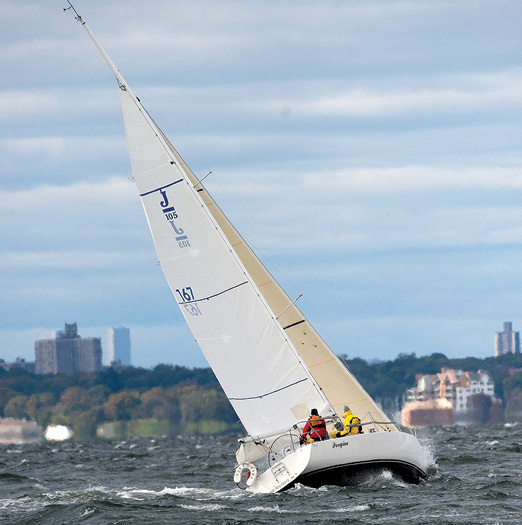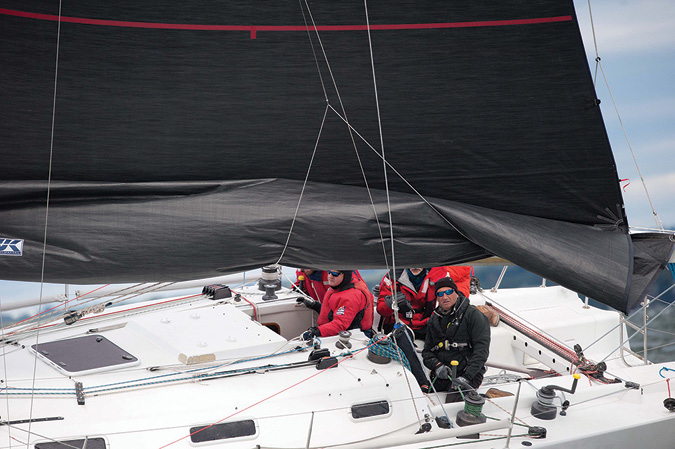By Adam Loory, General Manager, UK Sailmakers International
Those of us at UK Sailmakers, as is the case with most sailmaking companies, have been working with sailors and sailing organizations to grow our sport through the development of new forms of racing that are both fun and accessible. Many people have told me they don’t race more because getting crew is such a problem. Reflecting that statistic, the number of boats competing in doublehanded distance races has grown over the last decade.

The crew of Josh Burack’s J/105 Peregrina are the winners of the inaugural Plus One Race. © Igor Annapolski
For several years I’ve been trying to get a new shorthanded racing series off the ground, recognizing that one appeal of shorthanded sailing is that it’s much easier to assemble a small crew than a large one. Since not every boat is set up to be sailed well with just two people, and because not all sailors want to exert as much energy sailing as doublehanders, I developed a new handicap crew-size format straddling doublehanding and fully crewed racing.
I’m calling this new series “Plus One” since the crew limit is one more person than the tens digit of the boat’s hull length. Therefore, any boat from 20 to 29 feet races with three crew, boats in the 30s sails with four, and so on.
To test the theory, I convinced the Storm Trysail Club and Larchmont Yacht Club to run a Plus One race after the last of the fall regattas on Long Island Sound. Those clubs are as dedicated to growing the sport as UK Sailmakers, so it was easy to get them to host the race. That first race was sailed Sunday, October 21 in a howling, cold northerly. The inaugural Plus One Race turned out to be a great test of heavy air seamanship, challenging every sailor to perform at the highest level.
With winds blowing 21 to 25 and gusting into the 30s, Nick Langone, the Storm Trysail Club’s Principal Race Officer, wasn’t sure if he should start the race. Instead of making the call, he polled the fleet over the radio and heard a unanimous “We are here to race!” Because no one flew spinnakers or changed jibs during the race it was not the optimal test of shorthanded crews handling sail changes, spinnaker sets, jibes and douses, but the Plus One teams sailed their boats under reduced canvas in conditions that many full crews normally elect to skip.

With multiple jobs for each crewmember, there’s no railmeat in the Plus One format. © Igor Annapolski
On my custom 40-footer Soulmates, we raced with a reefed main and No. 4 genoa. Unfortunately, the jib halyard broke just before the gun, which made us have a late start, but the crew came together and we fought our way back to cross the finish line first. Josh Burack’s team sailed his J/105 Peregrina well and crossed the finish line second, taking first place on corrected time. Justin Scagnelli’s J/88 Albondigas finished third, with Alex Helfand’s Hunter 37 Shadowfox fourth. Twelve boats registered for the race, seven made it to the starting line and six started. Only four finished on a day with winds gusting into the 30s and a wind chill in the 30s.
“We saw 35 knots of wind, yet nothing broke,” said Alex Helfand. “I am very happy. I like the [Plus One] crew format. While we didn’t get to test flying the spinnaker, a solid crew of four makes for a very enjoyable day. There was not one point where I raised my voice; everyone worked well together and had plenty to do.”
Even though Hamish Young’s Beneteau First 36.7 Jamala IV had to drop out because of a torn jib, his crew had a good time. A veteran of many doublehanded races, Hamish is a Plus One convert. “I have two sons who sail with me, and whenever I raced doublehanded I had to leave one son home,” he said. “Now I can sail with both sons and one more, too. I’m looking forward to more races with this crew configuration.”
What we wanted to show with this race are the benefits of Plus One over doublehanded racing. First, not all boats are set up for competitive doublehanded racing. Further, if one sailor goes overboard, a singlehanded MOB retrieval is not within every sailor’s skill set. With Plus One, there are still enough people to manage headsails with luff tapes and spinnakers that are set without a sock. At the same time, because you’re not sailing with the full complement of crew, everyone’s more involved with racing the boat. There are no purely “railmeat” crewmembers; everyone has multiple jobs so they learn different skills, and owners have fewer bodies to wrangle before leaving the dock.
As the creator of the Plus One concept, I really wanted to get the first race off, but the weather forecast five days before the race was worrying. I kept telling those concerned about big breeze, “Don’t worry. It’s way too early to predict winds we will have.” But as Josh Reisberg pointed out, “This was the first time in memory when the wind forecast was spot-on five days in advance.”



